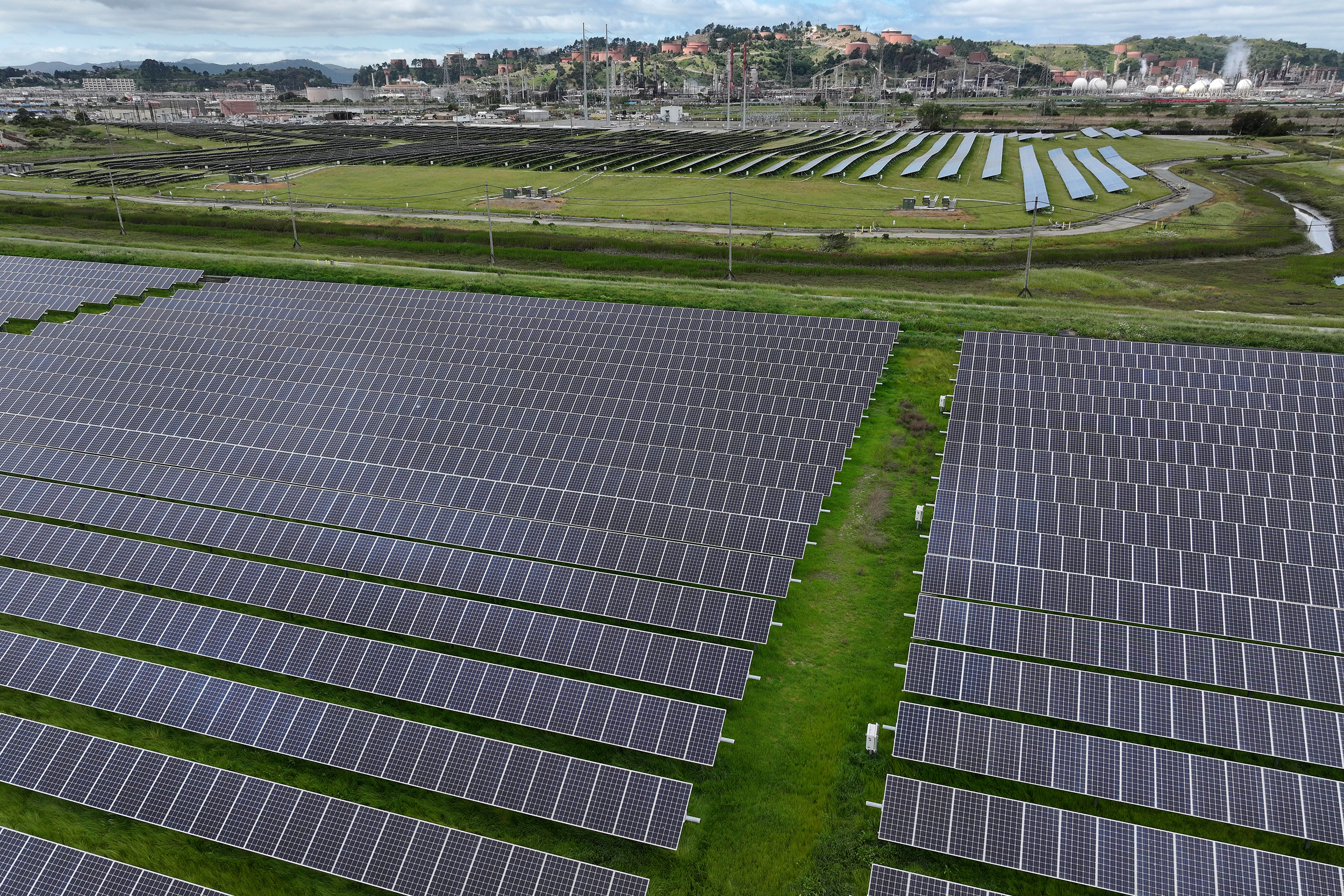When gaming out various election scenarios, Jason Walsh originally thought it was possible but unlikely that Republicans would score a governing trifecta winning the U.S. House of Representatives, the Senate and the presidency.
As executive director of the nonprofit BlueGreen Alliance, Walsh was a behind-the-scenes leader lobbying the Biden-Harris administration to pass the landmark climate policies that became the 2022 Inflation Reduction Act.
Now, that scenario has come true, and Walsh finds himself in a new fight to safeguard the tax incentives designed to spur clean energy growth against repeal by an incoming Trump administration and Republican-controlled Congress.
“This is one of the defining fights of our time,” Walsh said in an interview with Inside Climate News. He added that the new jobs and manufacturing benefits are “so obvious and spread so broadly across the country that repealing that law would be economic malpractice, in addition to being climate malpractice.”
In two years, the Inflation Reduction Act has helped spark a green manufacturing boom with hundreds of billions of dollars in private investments and accelerated the growth of renewable power on the grid. In addition to grant and loan funding for renewable energy projects, the key policy mechanism in the act is tax credits. These payments from the U.S. treasury can either cover a portion of the upfront investment cost of a new facility or pay companies a fixed rate for clean energy delivered to the grid or products such as solar panels and electric vehicles that are manufactured in the United States.
The tax credits have sped up the U.S. transition away from fossil fuel power, a major driver of climate change. To its champions, the IRA is the most significant law passed so far to curb carbon emissions. But to many conservatives, the law is a wasteful use of taxpayer funds and overreach into the energy market.
President-elect Donald Trump has pledged on the campaign trail to “rescind all unspent funds” allocated by the IRA. The law’s $7,500 credit for buyers of new electric vehicles has also drawn the ire of Trump and other Republicans.
Project 2025, the plan from the conservative Heritage Foundation for the next Republican administration, directly calls for repealing the IRA. Since the GOP took control of the House following the 2022 midterms, they have voted more than 50 times to repeal all or part of the law.
Path to Repeal
The most likely path to Republicans rolling back the Inflation Reduction Act is using the same budget reconciliation process through which Democrats were able to pass the law in 2022 with a simple majority. Taking up the issue in 2025, the Republicans also are intent on extending the tax cuts passed in Trump’s first term that are expected to blow a $4.6 trillion hole in the budget over 10 years, according to a report by the Congressional Budget Office.
Some members will be looking to balance that deficit with spending cuts, and tax credits for clean energy could easily be on the chopping block. To preserve Biden’s legacy, Walsh and other climate advocates are banking on support from Republicans such as the 18 GOP Congress members who in August wrote a letter to House Speaker Mike Johnson (R-La.) urging him not to repeal the tax credits that have helped create jobs in their districts.
Catherine Wolfram, an economist with the Massachusetts Institute of Technology’s Climate Policy Center, said the letter from Republican Congress members “is going to stop anyone who’s thinking about wholesale repeal,” of the IRA.
Although their numbers are diminished to 13 members who signed the letter and won reelection, with one race yet to be called, there are theoretically enough votes to stand with Democrats in defense of the IRA. Speaker Johnson responded to the letter prior to the election, telling CNBC, “you’ve got to use a scalpel and not a sledgehammer” to roll back tax credits. But there is not a clear consensus on what components Republicans want to cut, or how steadfast those members will remain if under pressure from party leadership.
In an email to Inside Climate News, a representative for Senator-elect John Curtis (R-Utah), one of the members who signed the letter, said that incentives for geothermal, nuclear and carbon sequestration are generally supported by Republicans. Investment and production tax credits will be “technology neutral” starting in 2025, meaning those technologies will qualify for incentives previously only given to wind, solar and batteries.
“It’s difficult to speculate on what’s ahead,” Curtis’ press secretary said, citing the challenge of balancing multiple priorities such as the national debt.
In an interview, another member who signed the letter, Rep. Earl “Buddy” Carter (R-Ga.) said, “all of us want domestic manufacturing. All of us want to secure our supply chains,” but he does not want the government “picking winners and losers.”
“I don’t think the federal government should be involved in telling people the type of cars that they are to drive or the type of appliances that they are to use,” Carter said. But, he stopped short of committing to whether or not he would support a rollback of the electric vehicle tax credit that helps create demand-side incentives for EVs.
Carter’s district covers the coast of Georgia, where Hyundai is building a massive factory to manufacture electric vehicles and attracting a swath of other companies building batteries and other EV parts. Although Hyundai began locating in Georgia prior to August 2022, the South Korean automaker, along with its nearby suppliers, stand to benefit from the tax policies of the IRA.
Clean Energy Boom Under Threat
Carter is not alone: at least eight of the 18 members to sign the original letter have major clean energy projects moving into their districts. Nationwide, more than three quarters of the private investment dollars in clean energy and EV manufacturing have gone to Congressional districts won by Republicans, according to estimates from Jack Conness, an analyst at the think tank Energy Innovation.
Since August 2022, more than 55 gigawatts of new clean electricity generation has come online and 42 new manufacturing facilities have set up shop, according to the American Clean Power Association. Two years after the IRA passed, the Bureau of Labor Statistics found that the clean energy sector was adding jobs at twice the rate of the rest of the economy.

In the coming years, that growth has been expected to accelerate. The trade group E2, which represents clean energy companies, has tracked nearly 400 new clean energy projects that have been announced since the IRA became law. According to the group’s recent report, the projects could create about 150,000 full-time jobs once up and running and just shy of half a million temporary construction jobs.
That growth came in no small part because with the IRA, “businesses finally got some visibility into what tax policy was going to be for the next ten years,” Bob Keefe, executive director of E2, told Inside Climate News.
But with the continuation of the tax credits under threat, Keefe said, “that clarity has vanished.” In October, Keefe and his team published a survey of 900 clean energy companies, in which 53 percent said they would lose revenue as a result of IRA repeal, 27 percent said specific projects would be canceled and 21 percent said they would have to lay off employees.
This story is funded by readers like you.
Our nonprofit newsroom provides award-winning climate coverage free of charge and advertising. We rely on donations from readers like you to keep going. Please donate now to support our work.
Donate NowScout Clean Energy, a Colorado-based company building and operating utility-scale solar, wind and battery storage is already facing project delays due to the post-election policy uncertainty, Anna Buongiorno, the company’s associate director of government affairs, told Inside Climate News.
But Buongiorno stressed that Scout Clean Energy, founded in 2016, will focus on ensuring they invest in the projects that make the most financial sense with or without tax incentives. “The renewable energy industry has been through this type of whiplash before,” Buongiorno said.
“The Transition Is Underway”
Even with possible delays, Dennis Wamsted, an energy market analyst with the Institute for Energy Economics and Financial Analysis, is confident that clean energy development is not going away. “The transition is underway. The question is, how fast is it going to happen,” Wamsted said.
Total energy demand is projected to grow, and Chris Ellinghaus, who does financial analysis for major electric utilities through the firm Siebert Williams Shank, said utilities and big tech companies will continue turning to renewable energy to meet a large portion of new demand coming from data centers, electric vehicles and manufacturing facilities.
“[Trump] can say all he wants about oil and gas, but that’s not what the fuel of future economic growth is,” Ellinghaus said.
There are signs of optimism on the manufacturing side as well.
Earlier this year, Spain-based PVH opened a new factory in Houston to manufacture the mounting systems known as “trackers” that shift solar panels’ angle as the sun changes position throughout the day. Rodolfo Bitar, the company’s vice president of business development, said PVH was planning to open the facility before the IRA, and with more than $35 million invested in the Houston facility, “it’s not something that we pick up and leave.”
Nevertheless, Bitar said a potential IRA repeal, “obviously impacts our bottom line to a point,” but it’s hard for companies to calculate exactly how to adapt given another uncertainty of the Trump administration: tariffs. For PVH, the possibility of new tariffs on some of the parts they import are as big a concern as tax credits.
Overall, Bitar worries that Trump’s policies could make clean energy more expensive, but given the demand for new energy, he doesn’t think it will be detrimental. “It might slow down the industry, just to reevaluate and see what the best outcome for the consumer is, but it won’t bring it to a full stop,” Bitar said.
About This Story
Perhaps you noticed: This story, like all the news we publish, is free to read. That’s because Inside Climate News is a 501c3 nonprofit organization. We do not charge a subscription fee, lock our news behind a paywall, or clutter our website with ads. We make our news on climate and the environment freely available to you and anyone who wants it.
That’s not all. We also share our news for free with scores of other media organizations around the country. Many of them can’t afford to do environmental journalism of their own. We’ve built bureaus from coast to coast to report local stories, collaborate with local newsrooms and co-publish articles so that this vital work is shared as widely as possible.
Two of us launched ICN in 2007. Six years later we earned a Pulitzer Prize for National Reporting, and now we run the oldest and largest dedicated climate newsroom in the nation. We tell the story in all its complexity. We hold polluters accountable. We expose environmental injustice. We debunk misinformation. We scrutinize solutions and inspire action.
Donations from readers like you fund every aspect of what we do. If you don’t already, will you support our ongoing work, our reporting on the biggest crisis facing our planet, and help us reach even more readers in more places?
Please take a moment to make a tax-deductible donation. Every one of them makes a difference.
Thank you,











